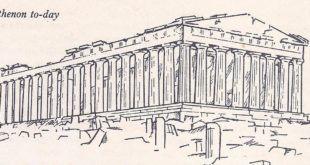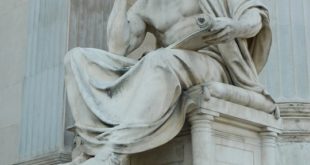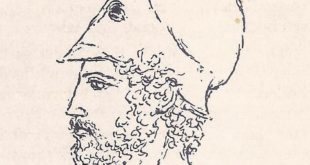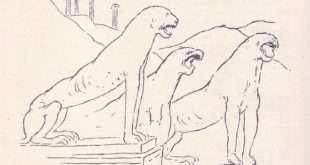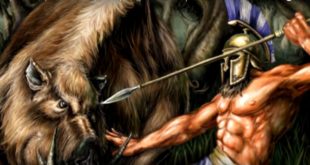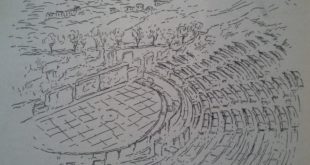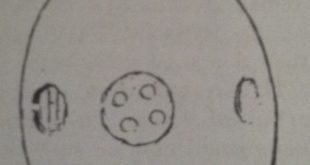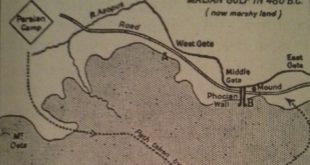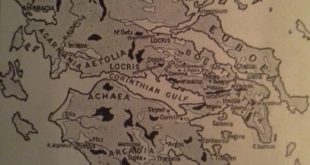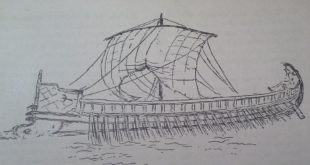In the year 437 the Parthenon, which had been begun ten years before, was far enough advanced to contain a gigantic statue of Athena by the sculptor Pheidias. Enough of the Parthenon still survives to give an idea of how it must have looked when it was new and a visit to the British Museum will fill in the details. Here some of the sculptured figures which adorned the temple may be seen. They are known as the ‘Elgin Marbles’ because Lord Elgin brought them back from Greece in 1802-4 to save them from Turks, who then ruled the Greeks. Now that the danger is past, the Greeks would like them back. Pheidias, who supervised their construction, would not necessarily have regretted that Athens had lost them. The Athenians treated him very badly. After his work was finished he constructed the statue of Zeus at Olympia (one of the ‘seven wonders of the world’) and thereafter returned to Athens. Enemies of Pericles, whose friend Pheidias was, then tried to attack Pericles through him. He was accused of impiety. It was alleged that he had introduced his own likeness and that of Pericles into the scene of Athenians fighting Amazons (tough mythical women) with which the shield of Athena’s statue was decorated. It was not a flattering portrait. He had represented himself as a bald old man about to heave a stone. He was put in prison and died of disease there in 432, the year in which the Parthenon was finished. The name ‘Parthenon’, by which Pericles’s famous temple later came to be called, is derived from a Greek word meaning ‘maiden’. It was dedicated to the Maiden Goddess, Athena and the gigantic statue of her was its greatest treasure. No trace of this statue now remains, and perhaps this is …
Read More »Herodotus, The Father of History
In 445, if tradition can be trusted, the Athenians must have felt more self-confident than ever; for it was then that Herodotus came to Athens, read aloud his history of the Persian wars and was given a reward. That the Athenians should have listened with interest as well as gratification is not surprising. The historian had done full justice to their distinguished part in the Persian Wars and in addition his work (9 books in all) contained all sorts of interesting details about countries like Egypt and Scythia (south Russia) which were only remotely connected with the war. Herodotus had travelled widely and produced a combined guide book and history covering most of the known world. No one had ever done anything of this sort before. “My duty is to report all that is said”, wrote Herodotus, “but I am not obliged to believe it all alike.” There is no doubt that people told him some odd stories, but the bulk of Herodotus is reliable. His History ends in the year 478. We have no detailed continuous account of the period 478-432. In 443 the Athenians founded a colony at Thurii in southern Italy and there Herodotus ended his days. Just when he went there is uncertain. We do not know whether he was still at Athens in 441 when a new dramatist, Euripides, won his first success, or in 440 when his friend Sophocles won a prize for his play Antigone (the name of the heroine). The Antigone is a tender play, which sets the audience worrying about how difficult it is to do one’s duty — loyalty to a friend may mean disloyalty to one’s country. This is a very real problem, though one best not pondered by soldiers. Their first duty must be unquestioning obedience to orders. …
Read More »The Athenian Empire
Cimon was rich and pro-Spartan, but generous. He kept open house and invited the public to make use of his garden and grounds. It was said that he got riches that he might use them and used them that he might get honour by them. This was in fact the course which Athenian Empire herself now began to adopt; but Cimon was not destined to steer her along it. He had a rival, Pericles. In 461 the queer process of ostracism was once again brought into operation. (For the events leading up to this see) Every citizen scratched a name on a piece of broken pottery. When the count was made it became clear that fear of Sparta meant more to the Athenians than the use of Cimon’s garden. Cimon had to go. For the next thirty years Athenian Empire was guided by Pericles. Pericles. He wears the ‘Corinthian’ type of helmet, which could be pulled down to cover the whole face for fighting. In 454 things went badly for Athens. She lost 200 ships which had been sent on an expedition as far afield as Egypt. What if the Phoenician vassals of Persia should choose this moment to raid Delos and rob the treasury of the League? They must not be given the chance. Once again, just as at the time when she had prevented the secession of Naxos, the action taken by Athens was very reasonable and at the same time very advantageous to herself. She removed the League’s accumulated wealth from Delos to Athens. Finally, in 451, rights of citizenship were restricted to men whose father and mother were Athenian born. This limited the number of those who were entitled to share in the spoils of what could now be called, not a confederacy, but an empire. While …
Read More »The Confederacy of Delos
Delos a Greek island in the Cyclades archipelago was an important religious centre in the Archaic and Classical periods. The island was also a major commercial and trading centre in the 2nd and 1st centuries CE. About the same time as the land victory at Plataea (479) the Greek fleet had beaten the Persians at Mycale on the coast of Asia Minor (478) and now that they were absolutely sure which was the winning side the Ionian Greeks of the coast and the islands gradually decided to change sides again, but they needed help. Persian garrisons had to be driven out. The Spartans might have undertaken this. They had been the acknowledged leaders of Greece on land and during the campaign against Xerxes, but the Spartans were not enterprising enough and they were always afraid that the downtrodden Helots might revolt, while their masters were campaigning outside the Peloponnese. So it was Athens which seized the opportunity and formed a confederacy of Aegean towns and islands for defence against Persia. Some larger islands such as Chios, Lesbos and Samos provided ships, but most members of the league contributed money. Aristides, old now but still renowned for honesty, decided how much each of the confederates should pay and the money was kept in earthenware jars at Apollo’s shrine on the island of Delos. From the first Athens was very much the leading partner and imposed strict discipline. When in 467, the year after the triumphant return of Theseus in his coffin, the island of Naxos tried to leave the Confederacy, it was forced to continue as a contributor. Athens insisted that since no Aegean city-state could help benefiting from the league’s activities, no state should be allowed to stay out of it. This is a reasonable enough argument, but one might have expected it to be used by …
Read More »Theseus Comes Home
The annual festival of the Great Dionysia, in March of the year 468, was not only remarkable for the victory of twenty-seven year old Sophocles over the honoured and battle-scarred Aeschylus, who was now approaching sixty. There was something else. Owing to the excitement which the competition between youth and age had aroused, the official whose duty it was to appoint the judges had not yet dared to do so. He was about to solve the problem in the way Athens solved many problems — by drawing lots — when Cimon, an aristocrat, politician and admiral, entered the great open-air theatre with nine of his senior officers. They had just returned from a naval expedition, during which they had subdued the island of Scyros, the supposed burial place of Theseus. An oracle had said that the body of Theseus should be brought back to Athens and Cimon had brought it (or someone else’s; there were no archaeologists to put awkward questions). Cimon was therefore the hero of the hour. The official in charge stood by the altar. (These drama festivals, were religious ceremonies, the god on this occasion being Dionysus.) With relief the official saw Cimon and his officers come in. Certain that his choice would be popular he led them to the altar and administered the judges’ oath. It was their decision which sent Aeschylus off to Sicily in a rage. For our present purpose the point of interest in this story is the huge coffin, alleged to contain the body of the mighty Theseus, which the Athenians had greeted with such rejoicing. That sort of demonstration over a legendary hero takes place either when a people is in great danger, or when they become ambitious. Now although Athens was still at war with Persia, the Persians had left …
Read More »Aeschylus
Play-acting had been developing at Athens since Peisistratus had introduced the Dionysia and the Panathenaea festivals; but to call it play-acting in the early stages gives a false impression. It was more like open air opera and ballet with a strong religious flavour. Originally there was a “chorus” of fifty men who chanted and danced in a dignified way. In the intervals an actor recited. Aeschylus added a second actor and the two actors, as well as conversing with each other, conversed with the chorus or its leader. All wore masks and impressive robes. Several plays were performed one after the other and the performance lasted all day. Later there were three actors, each of whom could play more than one part and a chorus of only fifteen. There were plenty of female parts, but they were always played by men. The little we know of the music makes it certain that we would have found it monotonous. It was usually provided by a man playing a kind of flute. Aeschylus grew up to the sound of poetry, but none of it was Athenian. Homer was Ionian; Hesiod was a Boeotian; so was Pindar (c. 522-442), who wrote odes in honour of victors in the Olympic games. Sappho, the woman lyric poet (c. 600 B.c.), was a native of Lesbos. Simonides, was from Ceos. There were many others, from the islands, from the mainland and even from Sparta. Aeschylus, however, is the first great Athenian poet of whom we know. The Persians was exceptional among tragedies in dealing with recent history. The characters in most tragedies were drawn from legend or the distant past, but Aeschylus was interested in the sin of getting above oneself, of getting too big for one’s boots and the conduct of Xerxes was an excellent …
Read More »“Wooden Walls” and Salamis
After Thermopylae the Spartans were only interested in defending the Peloponnese. Their next line of defence was across the Isthmus of Corinth. The atmosphere on the two sides of that line was now very different. Much of the Peloponnese was still far from the war. At Olympia the four-yearly games were taking place as usual. (Who on earth was free to attend them? one wonders.) North of the Corinthian gulf, however, townsmen and countrymen alike knew that the Persian army would be on top of them any day now. Knowing this, what did they do? The men of Delphi routed the Persian force which hoped to plunder the treasures of their sanctuary. They were helped by a storm and probably by some hocus-pocus arranged by the resourceful priests of Apollo. The men of Baeotia, with its capital, Thebes, put up no opposition and submitted to Persian occupation. The Athenians evacuated Attica, moved their families over to Salamis, Aegina or the Peloponnese and waited to see what Themistocles and his ships would do. Themistocles had been with the Greek fleet at Artemisium, opposing the Persians at sea, while Leonidas fought them on land. He then moved south, inscribing propaganda slogans on the rocks, where he hoped the Ionians in the Persian fleet would read them and be moved to but when the Persian fleet later passed that way (there had been a period of shore leave for the sailors to inspect and exult over the Spartan deed) no Ionian showed any sign of wanting to change sides. The Persian army advanced through Attica and entered Athens. The Delphie oracle had said that Athens would he kept safe by her “wooden walls” and a few diehards, refusing to take part in the evacuation, remained behind a wooden barricade on the Acropolis. They learned …
Read More »Thermopylae
The first narrow place where the Persians might have been held was the pass of Tempe in the north of Thessaly. A force was sent there but withdrew when news came that the Persians might take another route and outflank them. Thessaly was thus abandoned to the Persians; but they were not to be allowed farther south without a fight. The only route lay through the pass of Thermopylae. Here Leonidas the Spartan, who was Commander-in-Chief of the Greek forces, decided to make a stand, while the combined Greek fleet kept watch near Artemisium on the Persian ships, which were sailing along the coast in support of their army. Thermopylae is still a position vital to the defence of Greece, but it is no longer a narrow pass. The sea has retreated. When Leonidas and his men took up their position it came close to the foot of the mountains, leaving only a narrow passage between. Xerxes was surprised when he was told that the pass was held. He was inclined to be contemptuous when a spy reported that the enemy troops were engaged in gymnastics and were combing their hair. In fact the spy had been looking at the cream of the Greek force — three hundred Spartans. It was the Spartan custom to wear long hair and to prepare for battle in this apparently lackadaisical fashion. These same men had been warned that the arrows of the Persians would be so numerous as to darken the sun, to which one of them had replied: “Excellent. We shall have our fight in the shade then.” Xerxes did not attack for four days, since he still expected the Greeks to retreat without fighting. On the fifth day however he sent a force with orders to capture the Greeks and bring …
Read More »The Second Persian Invasion
Darius I died in 486. In the last years of his life he had no need of the slave who had whispered. “Sire, remember the Athenians.” He remembered Marathon all too well and was making preparations for another attack on Greece. These preparations were continued after Darius’s death by his son Xerxes. By the year 480 an enormous force had assembled at Sardis and a fleet was ready to sail in support. This “Persian” army and fleet was in fact made up of contingents drawn from all over the vast Persian Empire, including Ionian Greeks. The march out of Sardis was a gorgeous and gigantic pageant. Dark Ethiopians had come in leopard skins from their mysterious country in the far south. Indians in a light cotton uniform represented the easternmost territories of the Empire. From the north came Scythian bowmen in long trousers and pointed caps. Xerxes himself rode in a chariot with picked Persian cavalry and spearmen marching in front and behind. Xerxes might well feel confident. The expedition had been carefully planned. Food and supplies had been collected along the route and a canal had been cut through the promontory of Mount Athos, so that the fleet might avoid the stormy passage round the end of it. Even the problem of crossing the Hellespont had been solved, though not without some unpleasantness. Two bridges consisting of hundreds of ships placed side by side had been built across the mile-wide strait, but they were soon destroyed by a storm. This infuriated Xerxes, who decided that the Hellespont should be brutally punished. Its waters were to receive three hundred lashes, to be branded, loaded with chains and ceremonially cursed. The penalty imposed on the builders of the bridges was less complicated. They simply had their heads cut off. Their successors …
Read More »The Rivals
After a battle there is a great deal of clearing up to be done. A small part of the Athenian force had been left behind to do this. The general in command was Aristides. “The Just”. There was no fear of his taking any of the rich Persian spoil for himself. He had gained a reputation for scrupulous honesty, for putting country before self and for modest behaviour. These qualities were rare. Perhaps as he returned to the Athenians after completing his task at Marathon, he felt that he had a good chance of occupying a powerful position such as had been held by Cleisthenes, whom he had known and admired. Far from it. A few years later Aristides was ostracised. On the day when the votes were cast it is said that an illiterate citizen, who did not even know Aristides by sight, came up to him and asked for help in marking the piece of broken pottery which served as a voting paper. The citizen wanted “Aristides” written on his. The owner of the name was a little surprised and asked the citizen whether Aristides had injured him in any way. “Oh no,” was the answer. “I haven’t even met him. But I’m tired of hearing him called ‘The Just’.” Aristides did not argue but wrote his name on the piece of pottery. If he had had less high principles and more sense of humour he would have written the name of his rival – Themistocles. Themistocles was pushy and boastful. In the company of artistic people he said, with slimy mock-modesty: “I’m sorry I can’t play any musical instrument. All I can do is to make a small city into a great one.” When a visitor from one of the Aegean islands belittled the fame Themistocles had …
Read More »